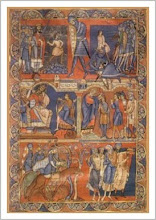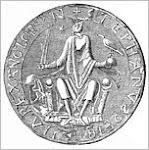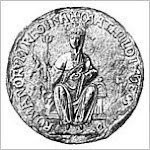• General Overview
• The Heptarchy - The Seven Kingdoms of Anglo-Saxon England
• Edward and the Godwins
• Invasion and Conquest
• The Normans
• The Normans
Normandy is located in northern France along the English Channel between Picardy in the east and Brittany in the west. Its name is derived from the settlement and conquest of the territory by Vikings during the ninth century. The Vikings (men of the North) had so harried the French coast that the French King granted lands to their leader Rollo. The fiefdom of Normandy was created in exchange for his homage and fealty. In time these Northmen absorbed French culture and language, intermarried, and by the time of the Conquest were indeed Norman French.
The Dukes of Normandy commissioned and inspired epic literature to record and legitimise their rule. Wace, Orderic Vitalis, and Étienne of Rouen were among those who wrote in the service of the Dukes.
Duke William of Normandy was the illegitimate son of Duke Robert of Normandy and a tanner's daughter named Herleva (Arlette) hence the name derogatory name 'Bastard'. When William became king of England following the Battle of Hastings in 1066 Normandy and England were linked by Norman rulers for a century and a half until it to reverted to French rule during the reign of King John.
The Normans introduced into England their system of land tenure based upon military service. The word feudalism is derived from fee, an estate in land. However they kept the whole system of Saxon of local governance and the counties, sheriffs, and courts survived. In short, Norman and Saxon institutions were blended. The Normans were also great builders, in the round arched Romanesque style. Great castles, keeps, cathedrals, abbeys and monasteries flourished. Even the most modest churches were enriched with ornate carvings, stained glass and chevron and beakhead ornamentation.
Rouen: a city on the Seine River, about 70 miles northwest of Paris. The site of Rouen was originally settled by Celts and later by the Romans as Rotumagus. Its name was changed to Rouen during the Middle Ages. The city was held by the English from 1066 to 1204 and from 1419 to 1449. It is known as the Museum City because of its historical and architectural treasures.
Caen: located on the Orne River about 9 miles inland from the English Channel, Caen is a major port and trade centre for the surrounding agricultural region. Caen served as the capital of Normandy under William the Conqueror. It was captured by the English in 1346 and was ruled by them from 1417 to 1450. Historical landmarks include the eleventh century Abbaye-Aux-Hommes founded by William the Conqueror, the Abbaye-Aux-Dames founded in 1066 by William's wife Matilda, and the Church of Saint-Pierre.
Bayeux: home to the famous Bayeux Tapestry, an eleventh century embroidery, which details the Norman Conquest of Britain, probably commissioned by Bishop Odo, Duke William's half brother, for his cathedral.
• The Gesta Normannorum Ducum:
One of the most important sources for the history of Normandy and England in the eleventh and twelfth centuries. It contains the earliest prose account of the Norman Conquest and was written by a succession of authors including William of Jumieges, who wrote for William the Conqueror, and later historians such as Orderic Vitalis d. c.1142 and Robert of Torigni d.1186:
The Gesta Normannorum Ducum
• Norman Conquests in other Lands
 Coin of Roger I, Norman conqueror of Sicily
Coin of Roger I, Norman conqueror of SicilyBesides the conquest of England the Normans expanded into other areas, perhaps most significantly Sicily. The sons of Tancred of Hauteville - William Iron Arm, Drogo of Hauteville, Humphrey of Hauteville, Robert Guiscard and Roger the Great conquered the Emirate of Sicily and additional territories in Southern Italy and carved out a place for themselves and their descendants in the Crusader States of Asia Minor and the Holy Land. Norman families, such as that of Tancred's, played important roles in the Crusades.
The 14th century Norman explorer Jean de Béthencourt established a kingdom on the Canary Islands. He received the title King of the Canary Islands but recognized Henry III of Castile as his overlord.
Notes:
This post concludes section 2. Setting the Scene: Background








